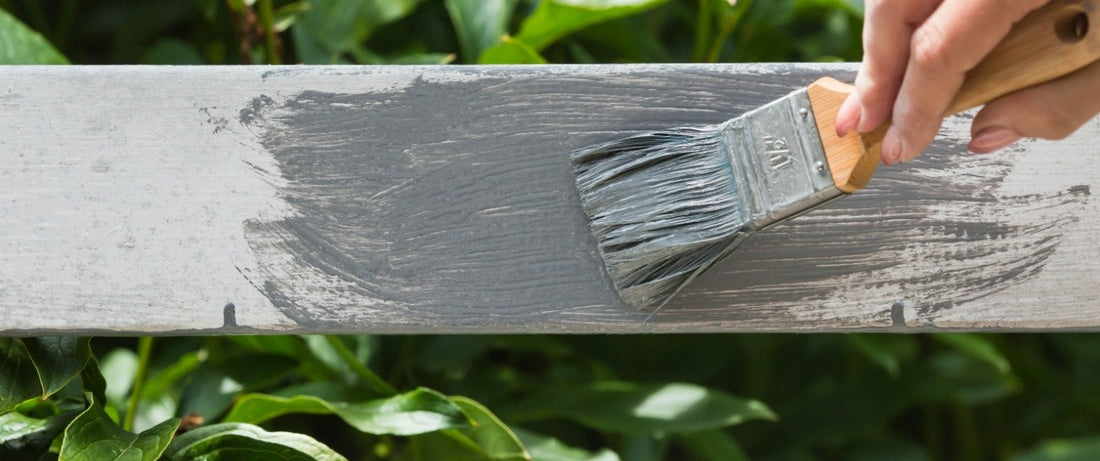Masonry Paint. Perhaps surprisingly, it’s not just reserved for use on bricks and concrete.
Yes, it may be specifically formulated and tested for use on external masonry materials – and is primarily used for this purpose. But the reality is, it’s a pretty versatile product, and can often be a great (sometimes even savvy!) option for use on outdoor wooden surfaces.
Whether you wish to restore your garden shed, want to spruce up the decking, or would like to give your fences a fresh coat in time for summer, here we explore why it may be worth ditching a traditional wood stain for a masonry paint alternative from Polar Coatings.
Benefits of masonry paint for wood
Masonry paint can be a suitable choice for wood-based paint jobs for several reasons:
- Extremely durable finish
It’s as tough as the surfaces it’s designed for.
Masonry paint is one of the most robust exterior paints currently available.
Not only is it incredibly hard-wearing and durable, it can also successfully protect the wood against harsh weather conditions and UV rays – ensuring it lasts for many years outside.
- Easy application
Masonry paint tends to be quite thick, which can be advantageous when applied to wood.
It’s super easy to apply using just a standard paintbrush or roller. For most projects, one coat is likely all you’ll need to create a smooth and uniform finish – meaning it’ll stretch further. And thanks to its thicker, more durable consistency, it’s less prone to chips and scratches.
- Convenience
If your project involves a mixture of masonry and wooden surfaces (e.g. a wooden fence with concrete posts), using the same paint for both can speed up and simplify the application process. Plus, as you don’t need to buy separate products, you could save a little money.
Use masonry paint, but use it with caution
The bottom line is – painting wood with masonry paint isn’t such a bad idea. But to ensure you get the best results, there are a few things you need to be aware of and should take into consideration, before you start to brandish your paintbrush.
- Breathability
Wood is a naturally porous material that requires a certain degree of breathability.
Whilst some masonry paints are made from ‘breathable’ ingredients, many aren’t.
Acrylic-based products, in particular, can be problematic. These essentially create a plastic barrier. And over time, moisture can get trapped behind this barrier – sometimes leading to moisture-related issues, such as swelling, shrinkage, cracks, warping, peeling and more.
If you do use masonry paint for wood, it’s worth opting for a water-based formula instead.
Generally speaking, these tend to be much more breathable. They’re still water-repellent, but they’re also usually permeable to water vapour – which means they won’t have a negative impact on the wood’s surface and the chance of these issues arising is greatly reduced.
- Flexibility
Unlike standard wood paint, masonry paint is not typically designed to flex with the natural expansion and contraction of wood (caused by changes in temperature and humidity). As a result, the paint’s surface could start to peel or crack much sooner than expected.
Again, it’s worth looking for a masonry product with better flexibility and elasticity.
- Adhesion
To ensure long-lasting protection, masonry paint is designed to create a protective layer that sits on top of the brick or concrete – which is why it’s so effective. But unfortunately, it also means it doesn’t adhere to the porous surface of wood quite as well.
Simply applying the paint straight onto the wood will likely leave you with patches, or paint that peels or flakes away. Therefore it’s more important than ever to do some prep work.
If you use masonry paint on planed timber, it’s worth sanding it down first (using 80 grit sandpaper). This will open up the surface, allowing the paint to penetrate and bind to the fibres much more easily. It can also be a good idea to water down the first coat of paint (by approximately 15-35%) and apply a high-quality primer to improve adhesion.
Polar masonry paint – suitable for masonry and wood
Admittedly, here at Polar, our masonry paint formulas have been specifically designed and created for use with the most common masonry materials – and this is where they excel.
But there’s no reason why they can’t be used on external wooden surfaces, too.
Incredibly hard-wearing yet water-based, they provide extremely long-lasting protection for the surface to which they’re applied – whilst also being flexible and water vapour permeable. Meaning, many of the potential concerns highlighted above can be easily avoided.
Providing you prepare well and apply it correctly, you shouldn’t have any issues.
Further technical details of our Polar Premium Masonry Paint and Polar Heavy-Duty WallGuard Paint can be found on their individual product pages. However, if you have any questions or are still unsure about the suitability of masonry paint for your project, please feel free to get in touch.
We’re always happy to assist with your enquiries. Start a live chat with a member of our expert team, send an email to info@polarcoatings.co.uk or simply give us a call on 0161 850 0379.




